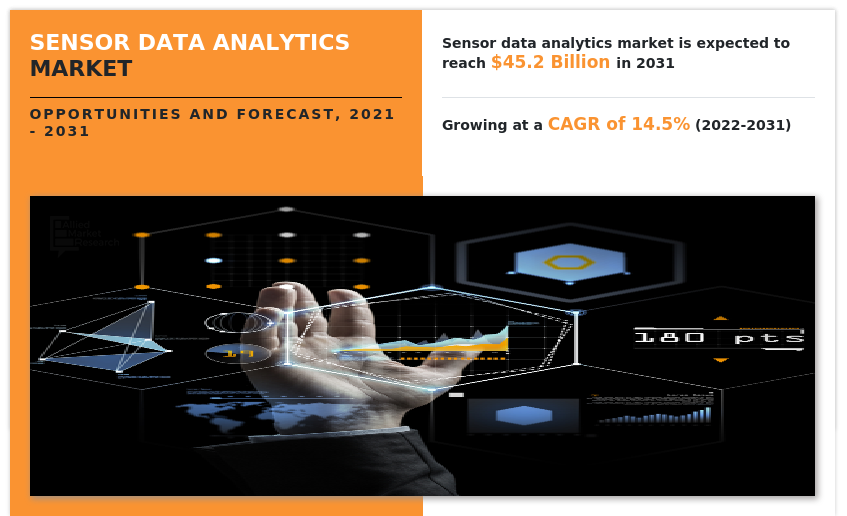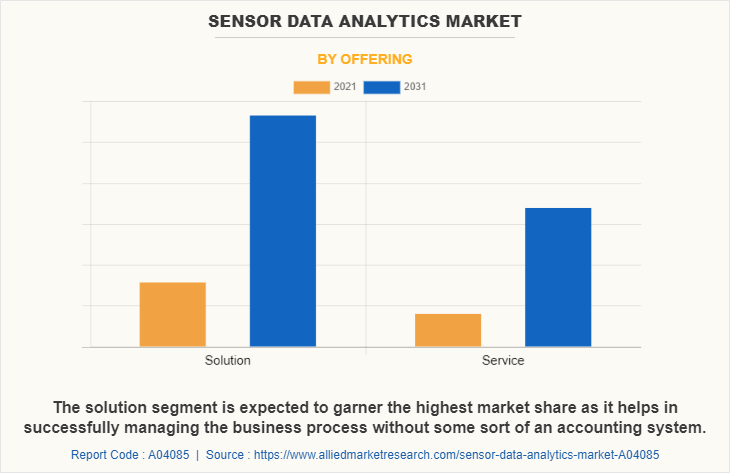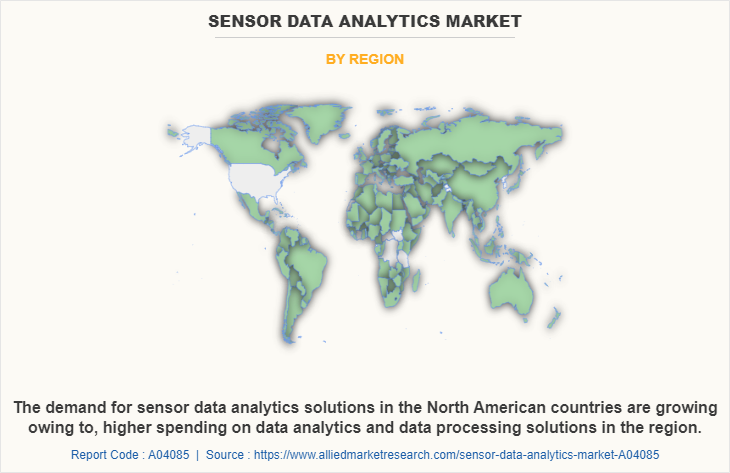Sensor Data Analytics Market Research, 2031
The global sensor data analytics market was valued at $11.8 billion in 2021, and is projected to reach $45.2 billion by 2031, growing at a CAGR of 14.5% from 2022 to 2031.
Sensor data analytics is a primary statistical tool to collect and evaluate the data that was originally formed from latest sensor in real-time. In addition, the valuable data can be made by wired sensors or latest wireless sensors medium. Furthermore, the most common important goal or strategy of sensor data analytics is to identify anomalies, and this real-time information can be applied for various modern applications. When there is a failure in a machine during manufacturing or sudden drop in patient’s health, these incidents can be monitored very quickly and easily and can be interrupted from major serious negative outcomes.
Rise in demand for wearables and increase in introduction of advanced sensors is driving the growth of sensor data analytics market. Moreover, rise in demand for various visualized real-time sensor data and information are boosting the sensor data analytics market size. However, high cost associated with installation and lack of skilled professionals and lack of awareness about sensor data analytics restrict the sensor data analytics market growth. On the contrary, increased usage of internet of things (IoT) and introduction of improved sensors are expected to offer remunerative opportunities for expansion of the sensor data analytics market during the forecast period.

The sensor data analytics market is segmented into Model, Analytics Technique, Tool Type, Enterprise Size, Industry Vertical, Offering and Deployment Type.
Segment review
The sensor data analytics industry is segmented on the basis of offering, deployment type, model, analytics technique, tool type, enterprise size, industrial vertical and region. On the basis of offering, the market is categorized into solutions, and service. On the basis of deployment model, the market is bifurcated into on-premise and cloud. On the basis of model, the market is divided into ad-hoc sensor, and real time sensor. On the basis of analytical technique, the market is classified into descriptive analytics, predictive analytics and prescriptive analytics. On the basis of tool type, the market is categorized into dashboard & data visualization, data mining & warehousing, self-service tools, reporting and others. On the basis of enterprise size, the market is classified into large enterprise and SMEs. On the basis of industry vertical, it is classified into manufacturing, aerospace & defense, energy & utilities, government & public sector, healthcare, transportation & logistics, retail, others. By region, the market is analyzed across North America, Europe, Asia-Pacific, and LAMEA.
The key players that operate in the sensor data analytics industry are Agt International Inc., Cisco Systems Inc., Cloudera, Inc., FogHorn, Google Inc., General Electric, Hewlett Packard Enterprise Company, IBM Corporation, Juniper Networks Inc., and Microsoft Corporation. Qualcomm Incorporated, Schneider Electric SE, Seeq Corporation, SAP SE, Tata Consultancy Services, Talend, and Verizon Communications Inc. These players have adopted various strategies to increase their market penetration and strengthen their position in the industry.

In terms of offering, the solution segment holds the largest sensor data analytics market share as it is attributed to rise in adoption of IoT & connected devices across a wide range of industrial operations majorly attributed to its market growth. In addition, due to rapid increase in utilization of sensor nodes, routers, and gateways to build network infrastructure for diverse customer sections, the demand toward hardware platforms is significantly impacted. However, the service segment is expected to grow at the highest rate during the forecast period as these services reduce the time and costs associated with optimizing systems in the initial phase of deployment.

Region wise, the sensor data analytics market share was dominated by North America in 2021 and is expected to retain its position during the forecast period, owing to technological advancements in the information and communication technology (ICT) sector and rapid rise of artificial intelligence (AI) & internet of things (IoT) within industries. However, Asia-Pacific is expected to witness significant growth during the forecast period, due to growth in number of big data analytics SMEs providing affordable solutions to the end users.
COVID-19 Impact Analysis
The sensor data analytics market has witnessed significant growth in past few years; however, due to the outbreak of the COVID-19 pandemic, the market is projected to witness a slight downfall in 2020. This is attributed to implementation of lockdown by governments in majority of the countries and the shutdown of travel across the world to prevent the transmission of virus. The sensor data analytics market is projected to prosper in the upcoming years after the recovery from the COVID-19 pandemic. Various organizations have initiated work-from-home culture for their employees, which is creating demand for the cloud-based sensor data analytics to manage critical information of organizations, thus creating lucrative opportunity for the market expansion during the forecast period. Surge in volume of data generated by different industries and the need to manage this data are the key factors that drive the growth of the market. In addition, governments of numerous countries have adopted sensor data analytics to update real-time data of coronavirus and to make actionable insights from the data. Furthermore, sensor data analytics is helping various researchers, healthcare workers, and scientists to aggregate and synthesize incident data on a regular and global scale. Moreover, companies have invented different search engines, which are expected to help countries to fight against the pandemic situation.
Top Impacting Factors
Rise in demand for wearables
Wearable devices such as wristwear, bodywear, and eyewear, are increasingly being used in healthcare and consumer infotainment, which in turn is driving the growth of the sensor data analytics market. In addition, wearable products technology has improved steadily, and the devices are becoming smaller, owing to which various manufacturers across the globe are implementing this technology in wearable devices. Furthermore, various key players of the market are introducing new technologies to improve their product and to enhance their customer experience, which in turn is driving the growth of the market. For instance, in July 2022, Digital Medicine Society (DiMe) released the Sensor Data Integrations. These toolkits help realize the sensor generated data to drive better decisions making process and to improve the company’s research process.
Rise in introduction of advanced sensors
Advancement of sensor technologies is being powered by high-speed and low-cost electronic circuits, signal processing methods, and advanced manufacturing technologies. In addition, synergetic interaction of new developments in these fields provides promising technical solutions increasing the quality, reliability, and economic efficiency of technical products. Moreover, using new technologies and signal processing methods, with well-known measurement principles could be used and considerably improved sensor features. For instance, in June 2021, Socionext America (SNA) has issued a new product brief, which helps provide a wide range of applications. Furthermore, advances in sensor technology have enabled automated devices to intelligently interpret sounds, images, and other data without the presence of extremely powerful processing. Thus rise in number of such product launches and solutions drives the market growth.
Key Benefits For Stakeholders
- This report provides a quantitative analysis of the Sensor Data Analytics Market Forecast, current trends, estimations, and dynamics of the sensor data analytics market analysis from 2021 to 2031 to identify the prevailing sensor data analytics market opportunities.
- The market research is offered along with information related to key drivers, restraints, and opportunities.
- Porter's five forces analysis highlights the potency of buyers and suppliers to enable stakeholders make profit-oriented business decisions and strengthen their supplier-buyer network.
- In-depth analysis of the sensor data analytics market segmentation assists to determine the prevailing market opportunities.
- Major countries in each region are mapped according to their revenue contribution to the global market.
- Market player positioning facilitates benchmarking and provides a clear understanding of the present position of the market players.
- The report includes the analysis of the regional as well as global sensor data analytics market trends, key players, market segments, application areas, and market growth strategies.
Sensor Data Analytics Market Report Highlights
| Aspects | Details |
| By Model |
|
| By Analytics Technique |
|
| By Tool Type |
|
| By Enterprise Size |
|
| By Industry Vertical |
|
| By Offering |
|
| By Deployment Type |
|
| By Region |
|
| Key Market Players | IBM Corporation |
Analyst Review
Sensor data analytics is a structured framework that helps the end user to build, acquire, transform, analyze, and report on different types of log data and sensor data. In addition, advanced analytics technology on sensor data is becoming an integral part of manufacturing, consumer electronics, and other industries to enable new value-added products, business processes, and services. Moreover, sensor data analytics has some applications that is used in different industries such as healthcare sensing, smart grid, smart meters, fleet management, product monitoring, smart appliances, anomaly detection & diagnosis, customer behavior analytics, predictive maintenance & reliability analysis, and others.
The global sensor data analytics market is expected to register high growth in the near future, attributed to rise in concern over the necessity to put the data in a quantified form and the need of accuracy in data process management. Moreover, increase in demand for various visualized real-time sensor data and information is driving the growth of sensor data analytics market. With growth in requirement for sensor data services, various companies have established alliance to increase their capabilities. For instance, in June 2022, Medidata partnered with 10 highly innovative organizations AliveCor Aural Analytics, Biobeat, Blue Spark Technologies, Glooko, Indie Health, University of Arizona, Carnegie Mellon University, University of Rochester, and University of Vermont. The strategic partnership to create new digital endpoints that could translate into more effective treatments and better healthcare for patients. Moreover, it helps in solving the challenges related to sensor integrations, standardization of sensor data, and the development of novel digital biomarkers and algorithms.
In addition, with further growth in investment across the world various companies have expanded their current product portfolio with increased diversification among customers. For instance, in May 2022, Google Cloud launched Manufacturing Data Engine and Manufacturing Connect to help manufacturers quickly create custom dashboards to visualize key data from factory KPIs such as Overall Equipment Effectiveness (OEE), to individual machine sensor data. For instance, in August 2020, Fitbit launched the Fitbit Sense, a new smartwatch with a variety of health features for users. The AMOLED display and EDA sensor incorporated within the watch, allows to detect the body's reactions to stress by measuring electrodermal activity responses. This sensor helped in calculating stress management score by analyzing heart rate data, sleep data, and activity level, along with measuring the user's skin temperature, for detecting signs of fever, illness, or the start of a new menstrual cycle. These factors are set to accelerate the market growth toward sensor data analytics in the future.
Moreover, with increase in competition, major market players have started acquiring companies to expand their market penetration and reach. For instance, in May 2021, Datalogic acquired M.D. Micro Detectors S.p.A Italian sensor manufacturer. The strategic acquisition allows the Group Datalogic to strengthen its Italian and global presence in the industrial automation market through the addition of inductive and ultrasonic sensors to its portfolio of products, with applications in a variety of industrial sectors including electronics, pharmaceuticals, logistics and automotive.
Rise in demand for wearables and increase in introduction of advanced sensors is driving the growth of sensor data analytics market. Moreover, rise in demand for various visualized real-time sensor data and information are boosting the sensor data analytics market size.
Region wise, the sensor data analytics market share was dominated by North America in 2021 and is expected to retain its position during the forecast period, owing to technological advancements in the information and communication technology (ICT) sector and rapid rise of artificial intelligence (AI) & internet of things (IoT) within industries.
The global sensor data analytics market was valued at $11.75 billion in 2021, and is projected to reach $45.15 billion by 2031, registering a CAGR of 14.47% from 2022 to 2031.
The key players that operate in the sensor data analytics industry are Agt International Inc., Cisco Systems Inc., Cloudera, Inc., FogHorn, Google Inc., General Electric, Hewlett Packard Enterprise Company, IBM Corporation, Juniper Networks Inc., and Microsoft Corporation. Qualcomm Incorporated, Schneider Electric SE, Seeq Corporation, SAP SE, Tata Consultancy Services, Talend, and Verizon Communications Inc. These players have adopted various strategies to increase their market penetration and strengthen their position in the industry.
Loading Table Of Content...


